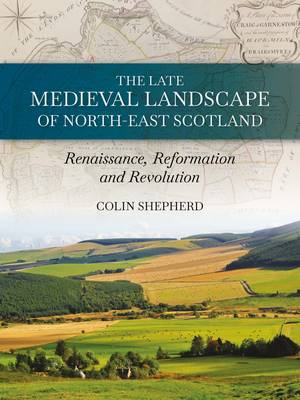
Door een staking bij bpost kan je online bestelling op dit moment iets langer onderweg zijn dan voorzien. Dringend iets nodig? Onze winkels ontvangen jou met open armen!
- Afhalen na 1 uur in een winkel met voorraad
- Gratis thuislevering in België vanaf € 30
- Ruim aanbod met 7 miljoen producten
Door een staking bij bpost kan je online bestelling op dit moment iets langer onderweg zijn dan voorzien. Dringend iets nodig? Onze winkels ontvangen jou met open armen!
- Afhalen na 1 uur in een winkel met voorraad
- Gratis thuislevering in België vanaf € 30
- Ruim aanbod met 7 miljoen producten
Zoeken
The Late Medieval Landscape of North-East Scotland
Renaissance, Reformation and Revolution
Colin Shepherd
Paperback | Engels
€ 66,95
+ 133 punten
Omschrijving
The landscape of the north-east of Scotland ranges from wild mountains to undulating farmlands; from cosy, quaint fishing coves to long, sandy bays. This landscape witnessed the death of MacBeth, the final stand of the Comyns earls of Buchan against Robert the Bruce and the last victory, in Britain, of a catholic army at Glenlivet. But behind these momentous battles lie the quieter histories of ordinary folk farming the land - and supping their local malts.
Colin Shepherd paints a picture of rural life within the landscapes of the north-east between the 13th and 18th centuries by using documentary, cartographic and archaeological evidence. He shows how the landscape was ordered by topographic and environmental constraints that resulted in great variation across the region and considers the evidence for the way late medieval lifestyles developed and blended sustainably within their environments to create a patchwork of cultural and agricultural diversity. However, these socio-economic developments subsequently led to a breakdown of this structure, resulting in what Adam Smith, in the 18th century, described as 'oppression'.
The 12th-century Renaissance, the Protestant Reformation and the Industrial Revolution are used here to define a framework for considering the cultural changes that affected this region of Scotland. These include the dispossession of rights to land ownership that continue to haunt policy makers in the Scottish government today. While the story also shows how a regional cultural divergence, recognized here, can undermine 'big theories' of socio-political change when viewed across the wider stage of Europe and the Americas.
Colin Shepherd paints a picture of rural life within the landscapes of the north-east between the 13th and 18th centuries by using documentary, cartographic and archaeological evidence. He shows how the landscape was ordered by topographic and environmental constraints that resulted in great variation across the region and considers the evidence for the way late medieval lifestyles developed and blended sustainably within their environments to create a patchwork of cultural and agricultural diversity. However, these socio-economic developments subsequently led to a breakdown of this structure, resulting in what Adam Smith, in the 18th century, described as 'oppression'.
The 12th-century Renaissance, the Protestant Reformation and the Industrial Revolution are used here to define a framework for considering the cultural changes that affected this region of Scotland. These include the dispossession of rights to land ownership that continue to haunt policy makers in the Scottish government today. While the story also shows how a regional cultural divergence, recognized here, can undermine 'big theories' of socio-political change when viewed across the wider stage of Europe and the Americas.
Specificaties
Betrokkenen
- Auteur(s):
- Uitgeverij:
Inhoud
- Aantal bladzijden:
- 240
- Taal:
- Engels
Eigenschappen
- Productcode (EAN):
- 9781914427046
- Verschijningsdatum:
- 17/09/2021
- Uitvoering:
- Paperback
- Formaat:
- Trade paperback (VS)
- Afmetingen:
- 185 mm x 246 mm
- Gewicht:
- 782 g

Alleen bij Standaard Boekhandel
+ 133 punten op je klantenkaart van Standaard Boekhandel
Beoordelingen
We publiceren alleen reviews die voldoen aan de voorwaarden voor reviews. Bekijk onze voorwaarden voor reviews.











